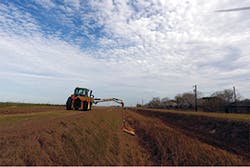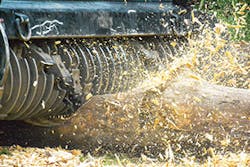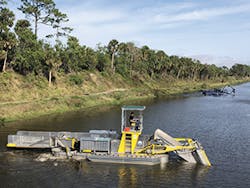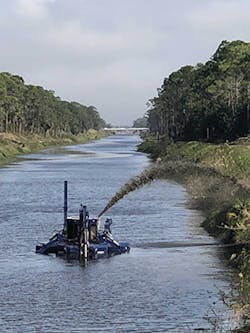Mowers are, literally and figuratively, the cutting edge for managing vegetation. And with new technologies and designs, they offer solutions that are also cost-effective.
Willacy County
“All of the mowers we’ve had are boom mowers with a 30-foot reach,” says Paul Greenhill, district manager of the Willacy County Drainage District, which is about 25 miles from Harlingen, TX. “That is the maximum length you can get, and we require that to mow some of our ditches.”
The land is flat in Willacy County. The drainage ditches were built in the 1980s to prevent damage from flash floods by containing stormwater runoff until it can infiltrate. The ditches, or laterals, discharge to Laguna Madre, one of only six hypersaline (saltier than the ocean) lagoons in the world.
Laguna Madre and its counterpart in Mexico form essential habitat for numerous species of endangered birds, both migrating and wintering. Most of it is protected by federal law or its adjacency to large private ranches.
Greenhill supervises two drainage districts in Willacy County. District #1 has 160 square miles of ditches. District #2 has 20 square miles of ditches.
He says that the slopes of the ditches are 2:1. They are planted with Bermuda and other types of native grass to keep the soil from eroding.
To keep up with all of the mowing, Willacy County got a new mower in December 2017, a Saber 30-foot boom model with swivel bracket made by Tiger Mowers of Sioux Falls, SD. It has a 60-inch rotary cutting head with two blades at the end of the boom.
“This is our first one from Tiger, and it is a whole different mower,” says Greenhill with enthusiasm. “The way the mower is attached to the frame of the John Deere tractor is different. Other mowers attach to one side of the tractor. The Tiger mower attaches to both sides, a full body frame attachment.”
He cites several advantages with this design. “The mower is much more stable. You still have to do counterweighting for balance because the mower is on one side, but not as much because the mower is more balanced [to start with]. The Tiger configuration is an awesome design. They perform a lot better and they are safer.”
He adds, “If I were betting on it, I would say that other mower companies will go to this design in the future.”
He also appreciates that “the metal and braces where they’re welded are tough, really heavy duty.”
Mowing season for the district starts at the end of February, or in early March if cold weather lingers. Typically, winters last from late December or January through February, and the grass goes dormant.
The amount of rainfall determines how quickly the grass grows. Keeping up with it isn’t the biggest problem, though.
“Our biggest challenge is people who throw trash into the ditches and plug up the drains,” says Greenhill. “They throw in hot water heaters and other stuff. Then we have to get an excavator there and clean out the ditch.”
All of the ditches have drains. Some ditches intercut with other ditches, so if one of those has its drain plugged, debris buildup and flooding can spread elsewhere.
“The area was mostly agricultural when the district began installing the drainage ditches, but now subdivision and roads are being built,” he notes. “There is a loss of water absorption into the ground, a lack of infiltration, so the water runs off.”
To someone looking at the land, “it would look perfectly flat, but for every mile, the slope drops 12 inches. If there were no ditches, the water would sheet-flow in a southeast direction.”
He adds, “It’s still more agricultural than businesses and homes, but the whole area of the Rio Grande Valley is experiencing growth.”
That growth has caused Greenhill concern about a few ditches. “Now they’re right beside a road, and a car could drive into them. We always try to avoid building a ditch close to a road.”
The drainage ditches vary in depth. The types of soils into which they’re dug are different, too. Some are of sandy loam and some are of clay or mixtures. The sides of those with the most sand sometimes cave in. When that happens, they are shored up with turf reinforcement mats.
“Sometimes we use riprap—broken concrete and rocks—to help hold the soil. With all of the development that has been happening, we have a ‘boneyard’ of broken-up concrete that we can recycle,” he explains.
The mowing crew consists of four workers. They work 10-hour days, Mondays through Thursdays, but are on call every day if needed to respond to a storm or other special situation. The schedule calls for each drainage ditch to be mowed once a month. “Depending on the weather and rainfall, we might have to go back in and mow in two weeks instead of once a month. I put out the hottest fires first,” says Greenhill.
Hurricanes can play havoc with keeping the drainage ditches mowed. When one is forecast, he says, “I try to stay close to the subdivisions and in town,” making sure these ditches are clear to handle the increased volume of stormwater.
All of the district’s mowers are kept inside. As for maintenance, “we try to stay ahead of it. We go with the manufacturers’ recommendations [for routine maintenance].”
The rotary mowers are greased once each working day. The tractors are greased once a week, to stay within the manufacturers’ warranties.
Greenhill started as manager in 2006 and lobbied his board of directors on the advantages of mowing the slopes of the drainage ditches with a boom mower. “All of the other districts around here were doing that, so we started in 2008,” he says.
Before the switch to boom mowers, keeping the vegetation in the ditches mowed required a lot of work because they had built-up sides, or berms, of dirt. “We used an excavator to take dirt out, to keep the slope at a certain angle,” he explains. “You can’t just drive an excavator out to the ditch. You have to load it on an 18-wheeler trailer with a flatbed.”
Before reconfiguring the ditches for mowing with a boom mower, “to do the mowing we flattened the berms so we could use the pull-behind mowers. The fuel consumption was a tremendous cost compared to slope mowing.”
Converting operations to using a boom mower on all of the ditches was a big undertaking. Greenhill, his board, and his crewmembers were convinced that it would pay off in the long run, and it has.
“It took two years, approximately, to get all of the ditches reconfigured,” he recalls. “Now we can get a lot more done. Without the boom mower, we could do only about one-fourth of a mile in a day. Now we might get 2 to 3 miles done in a day, and the boom mower uses a whole lot less fuel.”
He says the department still has an excavator. “It can never go away entirely. If a ditch caves in, we would need the excavator [to reconfigure it]. But when we have grass growing and its roots hold the soil in place, that maintains the integrity of the ditch. Economically, there is no comparison between using a slope mower and using the excavator.”
Cutter head
Safety in South Carolina
With lots of vegetation to cut in a state with a long growing season, cutting heads on mowers get a lot of use over a year. They need to be durable and safe.
John White, supply and equipment manager for the South Carolina Department of Transportation (SCDOT), says, “We made a decision to go from rotary heads to flail heads on boom mowers because of safety. We want to reduce the frequency of objects being thrown into traffic or at the operator. Sometimes we mow in tandem, and one mower’s cutting head could throw debris at the other mower operator.”
He notes that the ditches contain a lot of debris. “It could be rocks or steel or woody material that comes off in big chunks. A flail mower is a slower operation, but it has increased safety.”
The Gyro-Trac’s flail head “spins vertically. It throws things down, compared to a rotary head that spins horizontally and throws things out to the side. That’s much safer,” explains David Cook, SCDOT’s director of maintenance.
SCDOT has flail heads from various manufacturers. White says that although all of them cut woody material into mulch, some perform better than others. “The Gyro-Trac seemed to hold up best and last longer, and it didn’t stall.”
SCDOT now has more than 100 of the Gyro-Trac heads. “Some were bought new on new equipment. Others were bought as replacements for other companies’ heads that still work, but not as well as expected. They’re slower or break down more often,” says White.
Cook says that he likes the way the Gyro-Trac’s teeth are attached to their drum. “Other mowers have teeth that flop around, but the Gyro-Trac has fixed teeth. The drum limits how much it can bite off at a time. It gives good production, and because of the gaps inside the ribs, the teeth stay cleaner. They don’t get clogged up with vegetation.”
White says that SCDOT crews “use boom mowers for two operations, for trimming limbs—generally with a saw blade—and for removing vegetation with a flail head.”
He says that the versatility of the boom mowers—mounting from the front or rear—makes the work easier. The choice of mounting direction makes possible such tasks as removing vegetation from the other side of a guardrail or the back side of a ditch.
Another advantage is that a boom mower can go on an excavator, tractor, or other types of machinery. “The equipment has to negotiate different types of terrain, boggy areas, and rocky areas,” explains White.
“South Carolina has the fourth-largest state-managed highway system in the nation, even though it’s a smaller state,” says Cook. “In bigger states, the counties and municipalities own their roads. We have over 41,000 centerline miles of roadways and 89,000 lane miles.”
The workload is further increased by South Carolina’s long growing season. “We start mowing in March and mow until mid-November,” says Cook.
Berky weed harvester AT 9150H
To manage vegetation on slopes and drainage ditches, SCDOT uses slope mowers or herbicides. Frequency on the different sites varies.
Roadside mowing along the shoulders—safety mowing—is handled by both independent contractors and SCDOT employees. Non-interstate roads are mowed four times a year. Starting in 2018, interstate roads will be mowed six times a year.
Cook says the outside contractors handle a large portion of the interstate mowing, especially in urban areas. “Our personnel address city mowing complaints, and in more rural areas, we do more mowing in-house.”
Boom mowers are used to cut tree limbs hanging over roadsides to increase visibility for drivers. Brush management, cutting down saplings and shrubs, is done periodically with slope mowers.
“Brush management is much slower, and we work on it all year. It’s more expensive to do. Clearing vegetation around bridges, for example, involves some hand work. We do that during the off-season,” says Cook. “Brush management is harder on equipment because you’re dealing with heavy, hard wood. Keeping the equipment going and operating at a reasonable cost is always challenging.”
Brush management is done on targeted cycles, sometimes every few years, depending on how heavy it is. Cutting vegetation that is 1.5 inches in diameter or less goes much faster than removing thicker, heavier plants.
Vegetation that is less than 3 inches in diameter at breast height is classified as brush. Any plants that are 3 inches or more in diameter at that height are considered to be trees.
For removing trees and heavier brush and performing right-of-way reclamation, SCDOT uses Shinn cutters or heavy-duty flail mowers.
SCDOT also has an herbicide program to manage vegetation. “We use chemical treatments to prevent regrowth. Sometimes we treat vegetation before cutting it. All of our operators are licensed technicians, and we apply chemicals according to the manufacturers’ labels,” says Cook.
The most common invasive plants that SCDOT works to keep under control, primarily with herbicides, are kudzu, Johnson grass, and cogon grass.
In the past, SCDOT has tried seedhead suppression to save the cost of mowing. “Some areas were more successful than others. Weather and the rate of application affect the success rates,” he says.
Considering SCDOT’s overall approach to vegetation management, he adds, “I think we have a good vegetation management effort, a well-balanced program, including both chemical and mechanical methods.”
Berky dredge machine
Cook notes the department has an equipment replacement schedule. “We have an expected life for all of our equipment. Usually, we need to replace more than we can afford to.”
He acknowledges that a major reason for managing vegetation is driver safety. Removing vegetation to give drivers—distracted and not—a clear view of roads, railroad crossings, and other roadside surroundings and obviously improves safety. The proximity of trees in relation to adjacent roads is a critical factor in preventing highway fatalities.
“Trees are our number one cause of fatalities in fixed object crashes,” explains Cook. “Drivers are distracted, run off of the road and hit trees.”
He hastens to add that SCDOT is not against trees. “Our goal is to have lots of trees, but not up against the side of roads, especially roads with high speeds [allowed].”
On interstates and other roads allowing high-speed driving, that means no trees or other vegetation—a clear zone—for about 45 feet from the edge of the road on each side, depending on the slope of the shoulder. Roads with lower speed limits have a clear zone of about 30 feet from the road edge on each side.
Noting that a lot of money is spent in designing and building roads, Cook says, “Roads are engineered for safety, with rumble strips that warn drivers they are off of the road, and paved level recoverable areas that allow them to drive back on. On grass or a steep slope, it’s difficult to stop or slow down.”
To keep vegetation from negating the benefits of such safety features, Cook stresses that “we want to keep the clear zones clear.”
Vegetation is allowed farther back from the road in the rights of way. A popular choice in South Carolina is crepe myrtle, a shrub with long-flowering, reddish-pink blossoms. Cook notes that crepe myrtle “is not a fixed object like a tree, and it doesn’t get that big in diameter.”
Year-Round in Florida
“We’re mowing all year. We never stop,” says Mike McCabe, district engineer for the Melbourne-Tillman Water Control District (MTWCD) in Palm Bay, FL.
Challenges to the mowing work include weather, invasive cogon grass, and infrastructure failure. McCabe says that when a canal crossing or outfall pipe in an adjoining area gets blocked, it often causes problems in the district.
The district was established in 1922 by the Florida legislature. It maintains a water management system to prevent damage from flooding, erosion, and excessive drainage. Funding comes from users’ fees, which are based on size and type of property.
MTWCD includes portions of unincorporated Brevard County, the City of Palm Bay, and the City of West Melbourne. Roughly rectangular in shape, the district measures 11.5 miles north to south and 9 miles east to west. It covers about 100 square miles.
The district owns and maintains more than 2,300 acres of canal rights of way and 163 miles of canals. Those canals are where a lot of mowing gets done.
The deepest canals hold 7 to 8 feet of water. The shallowest ones hold only 1 to 2 feet. In Florida’s months of hot weather and heavy rainfall from May to November, roughly during hurricane season, many plants thrive, including submerged vegetation growing in the canals. Mowing it involves first cutting the plants loose. McCabe is pleased with a new tool his department bought in the fall of 2017 specifically for this purpose, a Trex-Duke model 6740 from Berky Mowing Machines of Homosassa, FL.
The Trex-Duke is a motorized dredging boat. It has pontoons for floating and stability in water. Tracks allow it to move along the ground or sides of a canal. It does both suction and bucket dredging, and its auger drive moves forward and backward.
MTWCD also took delivery of a new weed harvester from Berky, a model AT 9150. It has a cutting width of 10 feet and a cutting depth of 6 feet, and its discharge chute is 12 feet long. It can cut vegetation and discharge it via the chute onto a maintenance bench. A tractor then spreads it and tills it into the ground.
Hydrilla is a prevalent invasive submergent plant that MTWCD removes from the canals, along with floating water hyacinths. Hydrilla grows so quickly that it can clog canals and areas around bridges. It does, however, absorb nutrients—phosphorus and nitrogen—removing them from the water as it is removed.
“We’re not looking to eradicate it, just control it. If left unattended it can take over the surface of a pond,” explains McCabe.
Lowering the nutrients in the area’s waters is a goal that MTWCD shares with other agencies in the region and state. “We accept runoff from other agencies which is loaded with pollutants and nutrients. We’re trying to help other agencies keep nutrients out of the Indian River Lagoon,” he explains.
The Indian River Lagoon is the most biologically diverse estuary in North America, with thousands of plants and animal species. In recent years, the lagoon suffered a large algal bloom, the result of increased nutrients flowing into the saltwater lagoon.
With nutrient load to the lagoon reduced, the chances of this environmental problem occurring again are also reduced. MTWCD’s mowing work is playing its part in protecting the lagoon for years to come.



